Navratri is celebrated twice a year for nine continuous days in honour of the nine avatars of Goddess Durga. Food is a significant part of any celebration/festival. If you think Navratri food list meals are limited and you would have to struggle to find things to eat for the nine days, you’re wrong. This extensive Navratri shopping list will help you maintain the fasting with all the joy, keeping all the eating guidelines for Navratri intact.
From ready-to-eat Navratri snacks to wholesome meals, this Navratri grocery list is sure to get your mouth watering, even if you aren’t observing the fast this year.
Ready to learn about some of our favorite Navratri essentials?
Table of Contents
Navratri Festival – What You Need to Know?
As we know, Navratri is celebrated not once but twice a year. Apart from mythological and spiritual reasons, there is a significant natural reason.
Navratri marks the end of one season and the beginning of a new one. There is a change in the length of days and how much daylight one receives.
The first Navratri, also known as Chaitra Navratri, begins during summers. While The Ashwin Navratri begins during the winters. Here is an upvas food list to help you prep meals quicker.
Significance of Navratri
- Since Navratri is around the time of seasonal changes, it helps the body keep negative energies away due to low immunity.
- Fasting helps in developing qualities like self-discipline and stronger willpower.
- The festival of Navratri symbolizes the victory of good over evil.
- It is a celebration of Goddess Durga defeating demon Mahishasura (winter Navratri)
- Fasting helps individuals attain bliss when combined with meditation.
- These nine days and nights of worship are a metaphor for the nine evils we face in our day-to-day lives.
- The nine evils are- lust, anger, greed, attachment, ego, fear, jealousy, inertia, hate, and guilt.
Your Ultimate Navratri Fasting Foods List
From grains and flours to fast-friendly seasoning and fruits, this is the complete list of Navratri food items you need to prepare yourself for this season.
This Navratri food list also contains several options you might already have in your pantry. In addition to these, nuts, seeds, and dry fruits make a major part of our Navratri food items.
Towards the end, you will also see a list of Pooja items that come in handy.
Finally, we have included some easy to prepare sweet and savory recipes in this list of Navratri food items. We listed few things to eat during Navratri fast.
Related Reading:
The best sabudana brands in India.
1.Kuttu (Buckwheat)
Kuttu, also known as singhara or buckwheat in English, is not a cereal. Kuttu flour is gut-friendly and rich in calcium and magnesium that helps to strengthen bones.
Kuttu is loaded with minerals that make it a must-have Navratri flour as the body goes through nine days of detox and resetting.
Why Kuttu for Navratri
- Kuttu is made using fruit seeds.
- Fruit seeds are not cereals. Therefore, kuttu is a pseudo-cereal.
- Kuttu provides a satisfactory feeling making it one of the best Navratri foods.
2. Amaranth (Rajgira)
Amaranth is believed to be a storehouse of nutrients. High in fiber and rich in vitamins, Amaranth is beneficial not just as a Navratri fast food but is also recommended as part of one’s daily diet. It helps the body to process iron which repairs muscles faster and maintains collagen levels.
Why Amaranth for Navratri
- Many Navratri special food items are not protein-rich. Amaranth makes for one of the most accessible fast-friendly protein sources due to its nutritional value.
- Amaranth contains all essential amino acids, even the ones our bodies cannot naturally produce.
- The fiber content in Amaranth helps maintain digestive health.
Auto Amazon Links: No products found.
3. Samak Chawal
Craving some rice during your fast? Well, it doesn’t get better than this. Samak chawal, also known as barnyard millet, is loaded with iron and magnesium. You can prepare sweet as well as savory dishes with this Navratri food.
Why Samak Chawal for Navratri
- The texture of barnyard millet is similar to broken rice that helps manage rice cravings.
- Rich in essential minerals, consuming Samak chawal ensures you meet your daily micronutrient needs.
- Its natural property of being low in sodium helps prevent water retention/bloating during Navratri fasts.
4. Rock Salt
Rock salt is a superfood in every sense! Rock salt contains a pure form of sodium chloride that has innumerable benefits. From curing muscle cramps to stabilizing blood pressure and improving digestion, rock salt is a staple Navratri food.
Why Rock salt for Navratri?
- Rock salt can be sprinkled over fruits to enhance the taste.
- Rock salt with nuts like cashew or roasted fox nuts helps deal with fried food cravings.
- Rock salt promotes better absorption of minerals.
5. Cumin
Flavor and taste apart, cumin seeds are full of antioxidants. As a Navratri fast food, cumin helps keep sugar levels in check. In addition to this, cumin also regulates digestion and acts wonders as a skincare product.
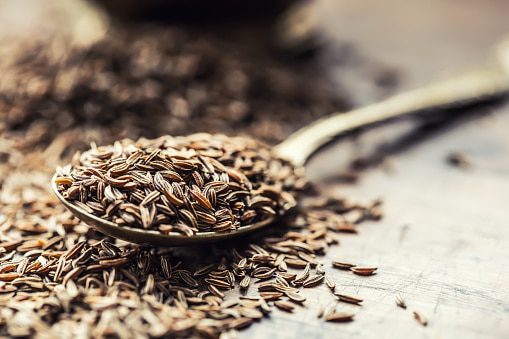
Why cumin for Navratri?
- When the carbohydrate intake is reduced, individuals observing fasts have trouble falling asleep. Cumin helps treat insomnia.
- Cumin seeds are known to boost immunity.
- Cumin removes toxins from the body, which is one of the primary purposes of Navratri fasting during the time of season change.
Auto Amazon Links: No products found.
Related Reading:
6. Black Pepper
Black pepper contains piperine that is known for its antioxidant, antimicrobial, and gastro-prospective modules. Consuming black pepper water is shown to significantly reduce appetite that may prove beneficial for some.
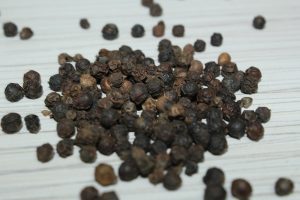
Why black pepper for Navratri?
- Since red chili is one of those spices that increase the temperature in our bodies, black pepper becomes a great alternative. Red chili is not allowed to be consumed during these nine days.
- Black pepper can be sprinkled over snacks like fruits/nuts.
- Black pepper can also be added to Navratri foods like sabudana.
7. Sugar
Our brains require a certain amount of sugar to function well. This amount depends on a variety of factors like age, gender, activity levels, etc. Rich in carbohydrates, sugar is an essential Navratri food that acts as a source of energy.
Why sugar for Navratri?
- Sugar can help deal with dessert cravings.
- You can prepare kheer using sugar and other Navratri fast food items.
- Sugar provides energy almost instantly.
8. Unsalted Peanuts
Peanuts have an exceptional macronutrient profile. High fats, medium protein, and minimal carbs- peanuts make for a great crunchy navratri fast snack. You can munch on them as a mid-meal snack or add a handful to your meals for an added layer of texture.
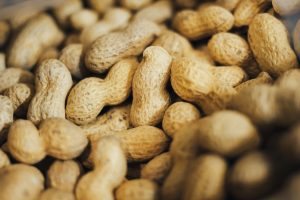
Why unsalted peanuts for Navratri?
- Unsalted peanuts are high in fats and offer a feeling of satiety.
- Unsalted peanuts (as use of regular table salt is prohibited during Navratri fasting) can be roasted/shallow fried to keep fried food cravings at bay.
- A Navratri fast-friendly snack using unsalted peanuts- blend peanuts into a paste and relish a spoonful with some sliced bananas.
- Raw peanuts can also be added to sabudana khichadi.
Auto Amazon Links: No products found.
9. Sabudana (Sago)
Sabudana has a natural cooling effect on our digestive systems that makes it an excellent Navratri food. In addition to this, sabudana is gluten-free and provides instant energy. Sabudana is also known for its property to promote great bone health.
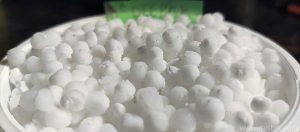
Why sabudana for navratri?
- You can make sweet kheer as well as savory khichadi using sabudana and other Navratri fast foods.
- Soak a cup of sago pearls, blend them into a thick paste for a Navratri fast dosa! To the blended sago paste, you are recommended to add some curd (for a batter-like consistency) along with another Navratri fast food like Samak or kuttu that helps the dosa retain its shape.
- Sabudana is rich in calories and makes for a wholesome meal.
Related Reading:
Enjoy these 4 tasty sabudana dishes during fasting.
10. Potato Chips
Craving something fried and salty? Potato chips are here to your rescue! Since the demand for navratri fast food is on the rise, brands have been making active efforts to manufacture fast-friendly snacks. These packaged snacks usually mention the type of salt used.
Why potato chips for Navratri?
- Potato chips instantly cure any junk food craving you might get during the nine days.
- Fast-friendly potato chips are readily available online as well as offline.
- They are easy to make and require minimal ingredients that are available in most Indian homes.
- Potatoes are loaded with nutrients.
11. Sabudana Papad
Most people have a habit of completing their meals with something crunchy yet light like a papad. Though you can’t consume the regular udad dal papad during Navratri fast, you can munch on some sago papad! Offering instant energy, sabudana papad is usually made with jeera that adds to the flavor.
Why sabudana papad for navratri?
- Sabudana (tapioca) is a great source of energy.
- These are a great way to add texture and taste to your meals.
- Sabudana papad is easily available.
12. Ladoo/Chikki
Desserts during fasting? Yes, we got you covered! Food to be eaten in Navratri fast does not have to be bland or boring. Here are a few options that cure cravings but also provide sustained energy for long hours.
- Peanut ladoos
- Rajgira ladoos
- Cashew chikki
- Mixed nuts chikki
- Til gud ladoos
All the above Navratri food items are made using fast-friendly food options. Jaggery is the base ingredient that helps with binding and forming the shape of the ladoos/chikkis.
13. Potato
If there is one thing we should learn from potatoes- it is their versatility. Consumed with almost every vegetable, potatoes are among those carbohydrate sources that are rich in fiber.
Fry them, roast them, add them to sago or samak chawal khichadi, the possibilities with potatoes are endless.
Why potatoes for Navratri?
- Potatoes are loaded with carbohydrates and fiber that make them a sustainable source of energy.
- Potatoes can be prepared in a number of delicious yet fast-friendly options.
- Potatoes are gluten-free.
14. Raw Papaya
Papaya when it’s green or unripe is called raw papaya.
We know about the benefits of papaya, but raw papaya?
Unlike ripe papaya, the raw version contains chymopapain and papain. These enzymes aren’t just beneficial for thyroid patients, but also in the overall digestion and assimilation of nutrients.
Why raw papaya for navratri?
- Raw papaya is rich in fiber and has a cooling effect on our bodies.
- Raw papaya can be grated and eaten as a salad. Top it with some sendha namak and roasted peanuts – and it becomes a nice cooling snack.
- Raw papaya is a good Navratri fast food for preparing a halwa as well.
15. Sweet Potato
Sweet potatoes are incredibly high in vitamin A. Much like white potatoes, sweet potatoes make for an excellent navratri fast food.
Sweet potatoes are naturally sweet and rich in carbohydrates and fiber, which helps to balance out sugar/insulin spikes.

Why sweet potatoes for Navratri?
- You could make sweet potato patties or a sweet potato chaat with a dash of lime.
- Sweet potatoes are a powerhouse of fiber and minerals, which may be difficult to consume with other navratri foods.
- Sweet potatoes are one of those Navratri fast foods that are rich in potassium.
16. Raw Banana
Uncommon vitamins and minerals that aren’t found in everyday foods are present in decent quantities in raw bananas. For instance, raw bananas are a rich source of vitamin C and B6. They are a good source of starch, especially during navratri fast.
Why raw bananas for Navratri?
- Raw bananas are rich in pectin, which is known for its satiating effect.
- Raw bananas help to maintain blood sugar levels that can fluctuate during fasting periods.
- Raw bananas keep stomach issues like gas, acidity, bloating at bay.
17. Pumpkin
Pumpkins may have a high glycemic index, but their glycemic load is relatively low. This means pumpkins do not skyrocket blood sugar levels. In addition to this, their fiber content provides satiety effects.
Why pumpkins for Navratri?
- You can boil and grate pumpkins to prepare Navratri fast-friendly halwa.
- The sweet and sour pumpkin sabji makes for a flavorful snack.
- It is a high-volume food which means low calories for a large quantity.
18. Bottle Gourd
Bottle gourd or lauki is a water-rich vegetable. Typically recommended during summers, bottle gourds help reduce stress, bringing down the level of bad cholesterol while being rich in vitamins C, K, and calcium.
Why bottle gourds for Navratri?
- Boil a grated bottle gourd with milk to prepare a quick and delicious kheer.
- You can also make squash and flavor it with salt and black pepper.
- Bottle gourd promotes better sleep which becomes a challenge when you are observing a fast.
Related Reading:
19. Coconut Water
Coconut water is among the best Navratri fast food items. Rich in potassium, a glass of coconut water will help manage the level of electrolytes in your system. Coconut water is naturally sweet and also a powerhouse of magnesium and amino acids.
Why coconut water for Navratri?
- When the food intake reduces, so does the level of hydration. Coconut water is a delicious way to keep yourself hydrated.
- Compared to caffeinated beverages, coconut water replenishes and nourishes the system.
- The malai/cream of coconut is a great source of essential fats and proteins.
20. Tomatoes
Tomatoes are hands-down a Navratri fast superfood. They are loaded with lycopene (antioxidant) that offers several health benefits. Tomatoes contain vitamins like- A, K, B1, B3, B5, B6, B, and C, and minerals like iron, potassium, folate, etc.

Why tomatoes for Navratri?
- You can prepare tomato juice, season it with some rock salt and black pepper.
- During Chaitra Navratri, tomatoes act as a natural protectant against harmful UV rays.
- You can prepare kele ke kofte or aloo sabzi in tomato gravy.
21. Cucumber
Cucumbers have 95% water content. This vegetable may be low in calories but it is loaded with essential nutrients. Cucumber slices with some salt in the summers is a classic. Here is how you can consume them during a fast:
Why cucumbers for Navratri?
- Cucumbers have high water content and keep dehydration at bay.
- They make for a great mid-meal snack that is light on the stomach.
- Cucumbers with homemade curd- a delicious raita!
22. Arbi (Colocasia)
Arbi is a Navratri food that is gut-friendly. Also known as taro root, arbi promotes a feeling of satiety by being rich in fiber. This navratri special food items is also a great source of starch.
Why arbi for navratri?
- Arbi can be fried and relished with some salt and black pepper seasoning.
- You can cook arbi with green chili for a quick salad.
- Arbi contains all the 17 essential amino acids.
23. Lemon
Lemons are among the best sources of vitamin C, specifically as a Navratri fast food. Lemons don’t just switch up the taste of Navratri food dishes, but they also make keeping yourself hydrated tasty!
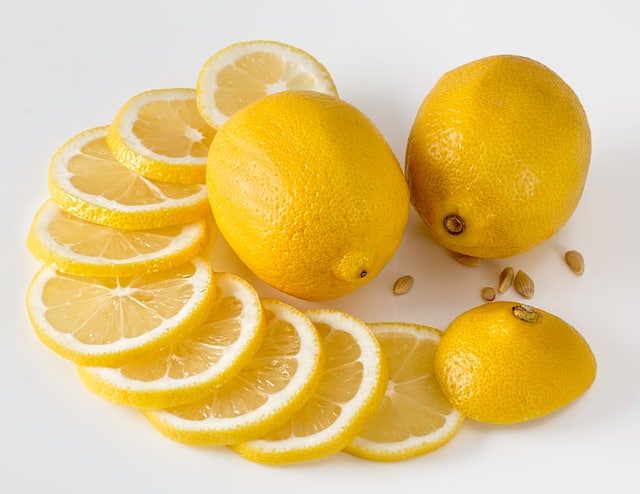
Why lemons for Navratri?
- Lemons are packed with nutrients like iron, calcium, magnesium.
- They help to boost immunity which makes it a must-have Navratri food.
- Lemons help in better assimilation of nutrients.
24. Green Chillies
Missing the heat from masale? Not anymore! Green chilies have strong spicy flavors. If they feel too intense, you can always slit them in half, use them as a tempering and take them out before serving.
Why green chilies for Navratri?
- They are naturally free of cholesterol.
- Green chilies promote better digestion.
- Green chilies are high in vitamin C that brings a natural glow to the skin.
25. Ginger
Does this Navratri food sound unconventional? It isn’t. All roots and tubers are permissible during fasts. From your tea to your meals, you can add flavor to all dishes using just a tiny piece.
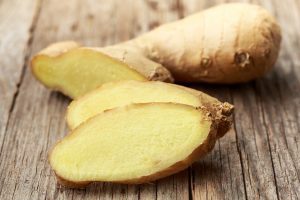
Why ginger for Navratri?
- This Navratri food makes a great seasoning agent.
- Ginger is helpful in treating nausea that may be experienced by some people observing fast.
- Ginger helps to deal with indigestion.
26. Water Chestnut (Singhara)
Water chestnuts are typically consumed in the form of flour. However, eating them as they naturally are, tastes surprisingly yummy! This nutritious Navratri fast food is very low in calories. Fiber, protein, potassium, calcium, manganese, copper, it’s all here.
Why water chestnuts for Navratri?
- This fiber-rich food keeps you fuller for longer.
- This fruit grows underwater and helps in cooling the body naturally.
- Fruit, flour, snack, this is a versatile Navratri fast food.
27. Curd, milk, paneer, buttermilk
Consuming dairy products is permissible during Navratri fasts. Curd and paneer are made using milk, whereas buttermilk is prepared from curd. Buttermilk and curd can also be consumed by those with lactose intolerance as the bacteria grown during the process help to digest the lactic acid.
Why curd, milk, paneer, buttermilk for Navratri?
- These Navratri food items are excellent sources of protein and calcium.
- Being low in carbohydrate content, these foods prevent lethargy.
- You can prepare Navratri fast-friendly desserts with milk.
28. Fruits
When it comes to fruits, you can enjoy all kinds! Apples, bananas, mangoes, and all other seasonal fruits. Fruits are full of fiber and natural sugars that keep cravings away.
Why fruits for Navratri?
- Apart from the obvious reason for the great taste, fruits are loaded with micronutrients.
- Not only are fruits filling, but fruits can also be added to desserts.
- They are rich in antioxidants.
- Fruits offer a wide range of textures.
Related Reading:
We reviewed Haldiram’s Navratri Thali and here’s everything you need to know about it.
29. Cashews
Cashews are among the tastiest Navratri food items on our list. Full of vitamin C, proteins, and good fat, a small handful of cashew nuts must be a part of your daily diet. In addition to these, cashews are a good source of copper, manganese, and magnesium that don’t just provide sustained energy but also promote immunity, bone health, and brain health.
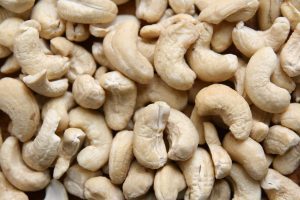
Why cashews for Navratri?
- Add to your bowl of Navratri fast-friendly kheer for a nutty texture.
- Cashews with raisins make a wholesome snack.
- You can prepare kaju katli or kaju barfi at home!
30. Almonds
Almonds are considered a superfood. From skin and hair to regulating blood pressure, almonds are a rich source of antioxidants. Almonds contain healthy fats, proteins, fiber, magnesium, and vitamin E. When consumed in moderation, almonds can do wonders!
Why almonds for Navratri?
- Almonds add a nutty texture to your Navratri fast desserts.
- Almonds soaked overnight help enhance the absorption of nutrients.
- Being rich in heart-healthy fats, almonds promote satiety.
31. Walnuts
Walnuts are one of the only plant-based sources of Omega-3.
Walnuts resemble the shape of a human brain and are known to strengthen memory and boost the functioning of our brain.
Why walnuts for Navratri?
- Walnuts are proven to decrease inflammation.
- Just 4-5 walnuts can fill you up.
- Walnuts require no pre-preparation.
Auto Amazon Links: No products found.
32. Makhana
Makhana, commonly known as fox nuts, is one of the only nuts in any Navratri food item list with more carbohydrates and proteins than fats. If you feel like switching things up with your Navratri fast food, try a bowl of makhana.
Why makhana for navratri?
- Makhana is light on the stomach.
- You can sprinkle some rock salt and black pepper over a bowl of makhana.
- Alternatively, you can also roast makhana with some sugar for a Navratri fast-friendly caramel popcorn.
Auto Amazon Links: No products found.
33. Dates
Rich in carbohydrates and naturally sweet, dates are a great source of instant energy. Dates have a rich nutritional profile and are high in fiber.

Why dates for Navratri?
- Dates warm the body internally, which is important during periods of seasonal changes- like navratri.
- Dates can be used as a natural sweetener.
- You can make some date paste, add chopped nuts, freeze this mixture, and you have a sugar-free dessert ready!
Auto Amazon Links: No products found.
34. Raisins
Small in size but packed with nutrients, raisins help improve digestion and boost iron levels. They are rich in fiber and essential minerals, and vitamins and prove beneficial when eaten in moderation.
Why raisins for Navratri?
- Pair a handful of raisins with cashews for a power-packed snack.
- Raisins can be added to Navratri fast desserts for a different texture.
- You can soak raisins overnight and consume them the following morning to prevent anemia.
35. Coconut
Coconuts are typically cracked/broken before commencing a new journey. A new car, a new house, a new business- cracking a coconut is supposed to be auspicious.
Similarly, coconuts are kept in pooja thalis. For the Navratri pooja, ensure your coconut is wrapped with a red cloth and tied with a red thread.
36. Kapoor
Kapoor or camphor is placed on a small handful of rice in the pooja thali. While the diya, better known as akhand jyoti is placed towards the left of the temple, the camphor is lit on the pooja thali.
The significance of using camphor during a pooja is- it destroys evil energies, and the fragrance brings positivity.
37. Ghee
Typically, diyas are lit using ghee. Specifically, grass-fed cow ghee. This is known to promote sattva components in the surroundings. Sattva is a subtle component that is characterized by patience, the ability to forgive, spiritual yearning, etc.
It is also believed that lighting ghee lamps eliminates diseases.
38. Incense Sticks
Incense sticks are always used during poojas as a symbol of sacrifice. Incense sticks turn to ashes but leave the room filled with pleasant fragrances. Not only Hindus, but Buddhists and Christians too use incense sticks during religious practices.
Fun Recipes You Can Prepare With Navratri Food
Here are 12 fun and easy recipes you can enjoy this Navratri.
1. Fresh Fruit Juice
- Are you tired of peeling and chopping your fruits? Fruit juice could be a tasty alternative. We would recommend you blend the fruits instead of juicing them to retain maximum fiber and flavor.
2. Sabudana Khichadi
- For the fluffiest bowl of sabudana, soak the required quantity overnight. Roast some boiled potatoes with cumin seeds, unsalted peanuts, rock salt, black pepper, and some green chilli for added flavors. Add the soaked sago to this mix and its ready! We have mentioned these items in our Navratri food items list.
3. Fruit Chaat
- Variety of textures and flavors during a fast? Yes! Chop up three to four fruits and season them with some black pepper. The natural sweetness from fruits and spicy flavor from pepper makes an exceptional snack.
4. Fried Potato
- Craving something rich? Make some potato fries at home. Important points to keep in mind- do not boil the potatoes; the first fry should be on a slow-medium flame-the second fry on a high flame for maximum crunch, use ghee when cooking for people observing fast.
5. Shakarkand Halwa
- Boil and grate some sweet potatoes. Cook them in ghee until you see the mix starts to leave the sides of the pan/vessel. Add sugar, chopped nuts and raisins.
6. Kuttu Poori
- Here’s how you can consume a wholesome, nutritious, and filling meal during Navratri. To the above-mentioned fried potato recipe, add some cumin seeds. To make the kuttu poori, knead the flour with water or ghee as per your preference. You can even knead this with homemade curd. Fry the pooris using fresh ghee. Voila!
7. Sabudana Kheer
- Instead of preparing sabudana like a khichadi, you can make a lip-smacking kheer. All you need to do is let the sabudana boil with milk until the milk thickens and reduces to half the quantity. You can add some saffron strands, sugar, nuts, raisins, etc. This is a soul-satisfying dish!
8. Barfi
- Typically distributed as a prasad, barfi is a creamy sweet dish made using milk solids as the base ingredient. Depending on the region, some flour may also be added to help the barfi set properly. However, since regular flours cannot be used during Navratri fasts, you can blend cashews or almonds and prepare the barfi using that.
9. Badaam Halwa
- Almond halwa has gained significant popularity due to the Keto diet. But this age-old dessert can be consumed during Navratri fasts as well. The preparation is easy, though time-consuming. That being said, the end result is 100% worth it!
- Grind a cup of soaked almonds (after peeling, yes this requires a lot of patience). You could also use store-bought almond flour. Once ground, roast the flour/paste in ghee with saffron strands, sugar. Keep stirring the mix to avoid burning and cook until the mix leaves the sides of the pan.
10. Dry Fruit Ladoo
- Wholesome, filling, and sweet-dry fruits ladoos are among the best Navratri food items. Grind dates to make a paste, cook the paste and add chopped nuts. Apply some ghee to your palms and shape the mix into ladoos.
11. Milk Rabri
- Take full-fat milk and boil it until it thickens into a rabri-like consistency. You can add saffron strands and some chopped nuts along with sugar.
12. Homemade Rasgulla
- If you know how to prepare paneer at home, rasgulla will be a piece of cake for you. After the milk curdles, separate the whey from the semi-solid substance and rinse it with water three-four times to remove any sour taste that may be present.
- Knead the semi-solid leftovers until you are left with a smooth dough-like product. Shape this into balls and dip it in a homemade chashni/sugar syrup. You could add chopped nuts to enhance the look and texture. Serve it cold!
Frequently Asked Questions
Here are some interesting FAQs on Navratri fasting foods:
Black pepper and cumin are permissible to be used during Navratri fasts.
Waking up early, taking a shower, wearing fresh clothes, meditating, and reading the Saptashati are some of the things you must do during Navratri.
Though permissible, tea/coffee and caffeinated drinks dehydrate the body. It is recommended to limit your consumption.
As long as the food items are permissible, you can eat snacks/meals whenever required.
It is advised not to sleep in the afternoons as it nullifies the good karma attained by observing fast.
Summary
There you have it – a complete list of Navratri fasting food list of food items along with the must-haves for conducting poojas on all nine days.
In addition to these, you must ensure to not leave your house vacant when the Akhand Jyoti is lit. At least one family member must be present.
We have compiled a list of some fast-friendly recipes for you to try. These can be easily prepared at home. We are sure you will not have to starve. We listed these things to eat during Navratri fast.







